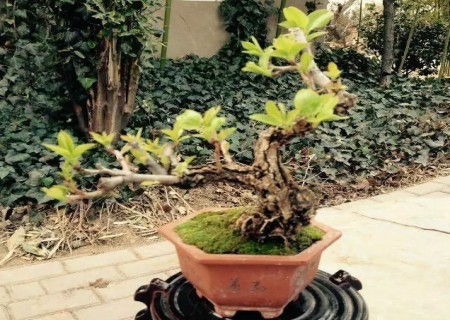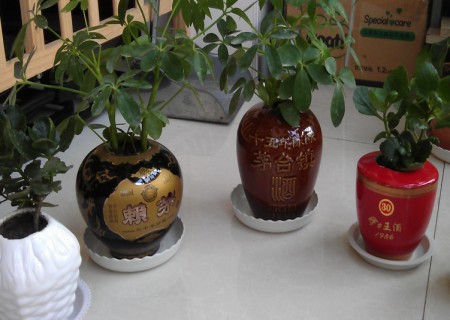The making method of Tangli Bonsai
Green carp came to hear the sound of Chunxi broken, sniffed the first light yellow stamens of hand-planted tang pears. When the summer passes quietly, the new pear gradually falls, and I come to invite my female companion from the east to pick up the fruit and return slowly. The old year picked fine snow branches, now falling rouge pear leaves, light grass color two or three into the volume, sipping spring wine light before feeling sweet. It is still the time to fall asleep in favor of pillow startling Hong. -- excerpt from "Tangli Fried Xue"
Tang pear is one of the main deciduous fruit trees suitable for bonsai, and there are many excellent varieties. Use it to make bonsai, admire flowers in spring, view leaves in summer, and eat fruit in autumn, and after falling leaves in winter, the gray-black cracked rough trunk shows more rugged, simple and natural characteristics, full of vigorous short fruit branches, such as chicken feet anchor hook hanging upside down, full of flavor.

Pear stumps with curved trunk, graceful tree posture and bonsai conditions can be directly selected to make bonsai. The roots of wild pear and pear trees are well developed. after root cutting and planting, it is easy to send new roots, and it is easy to survive in the pot. The following is the method of making Tangli bonsai:
1. Draw materials
Pile head selection in Central China can be carried out in late autumn and early winter by selecting wild Tang pear and other pear rootstocks with traditional bonsai conditions, which is simple and easy.
2. Soil
Pear trees like to fertilize loose and well-drained soil, and the cultivation substrate can be prepared with rotten leaf soil, garden soil, cinder or coarse sand, and mixed with mature organic fertilizer and bone powder as base fertilizer. The pot culture is especially good for the neutral loam which is loose and fertile and rich in humus pH value about 5-8.
3. Upper basin
After putting on the basin, pour enough water, place in the shade of the leeward, and often spray water to moisturize, wait for the bud and then move to the place with sufficient light for normal maintenance.
4. Watering
When growing, you should fully water and keep the basin soil moist. However, moisture should be properly controlled in the leaf expansion period to control the vigorous growth of branches and leaves, so as to avoid the influence of large leaves and sparse leaves on ornamental. And excessive vegetative growth is not conducive to plant reproductive growth, flower bud differentiation period (generally from the middle of June) should pay attention to reduce the amount of water.
5. Fertilization
Pear trees like fertilizer, do not tolerate barren, and apply fertilizer every 10 days or so in the growing season. During the period of flower bud differentiation and fruit growth after flowering around July, fertilizers based on phosphorus and potassium should be applied to promote flower bud differentiation and fruit growth. Avoid large fertilizer and water and simple application of nitrogen fertilizer to avoid excessive vegetative growth of plants and affect flowering and fruit hanging.
4. Pruning
In order to maintain the stump shape, it is necessary to prune the middle fruit branches. Vegetative branches are also divided into growing branches, growing branches and mediocre branches. According to the modeling needs, cut short the above branches and cut off the overgrown branches that disturb the tree shape, the over-dense mediocre branches and the budding shoots on the rootstock.
5. Modeling
Tang pear is suitable for making bonsai in many forms, such as direct dry type, oblique dry type, curved dry type, double dry type, facing water type and so on. But the blade is larger, it is not suitable to tie it into pieces, it is more appropriate to use natural shape.
6. Turn the basin
In order to keep the tree strong and blossom and bear fruit, the pot should be turned every 2 years. When turning the basin, it is necessary to cut off too many over-long old roots and withered roots and replace them with new soil to promote new roots and maintain exuberant tree momentum.
7. Pollination
Due to the small number of pear bonsai, single varieties or inconsistent flowering period, the self-flowering seed setting rate of most varieties is not high. Therefore, artificial pollination should be carried out to improve the seed setting rate. Artificial pollination should be carried out about 6 days after flowering, or different varieties of pear trees can be put aside to allow them to pollinate each other.
8. Fruit protection
The climate is capricious from May to June. If there is a strong wind in the young fruit period, it is necessary to move into the room in time to avoid blowing off the fruit. When viewing the fruit, the indoor display time should not be too long, the room temperature should not be high, and give sufficient light as far as possible, and often spray water to the branches and leaves, otherwise it is easy to cause early fruit drop.
9. Diseases and insect pests
There are powdery mildew, pear black heart disease, pear embroidery disease and aphids, heart-eating insects, red spiders, spider moths, leaf rollers, pear net bugs and other diseases and insect pests, which should be prevented and controlled as soon as possible.
Time: 2019-05-26 Click:
- Prev

The method of making potted wine bottle bonsai
Bonsai of various shapes and shapes are already common, such as dragon-style plum stakes, Jiaolong-style Luohan pine, oblique dry elm and so on, but if you want to associate these bonsai with unrelated wine bottles, you must be surprised or even surprised? Making wine bottle bonsai
- Next

The method of making cement rockery bonsai
Cement-plastic rockery refers to the artificial rockery made of modern materials such as concrete, FRP, organic resin and non-stone materials such as lime, brick and cement. Plastic hill and plastic stone can save the working procedure of quarrying and transporting stone, the shape is not limited by stone, and the volume can be large or small.
Related
- Fuxing push coffee new agricultural production and marketing class: lack of small-scale processing plants
- Jujube rice field leisure farm deep ploughing Yilan for five years to create a space for organic food and play
- Nongyu Farm-A trial of organic papaya for brave women with advanced technology
- Four points for attention in the prevention and control of diseases and insect pests of edible fungi
- How to add nutrient solution to Edible Fungi
- Is there any good way to control edible fungus mites?
- Open Inoculation Technology of Edible Fungi
- Is there any clever way to use fertilizer for edible fungus in winter?
- What agents are used to kill the pathogens of edible fungi in the mushroom shed?
- Rapid drying of Edible Fungi

